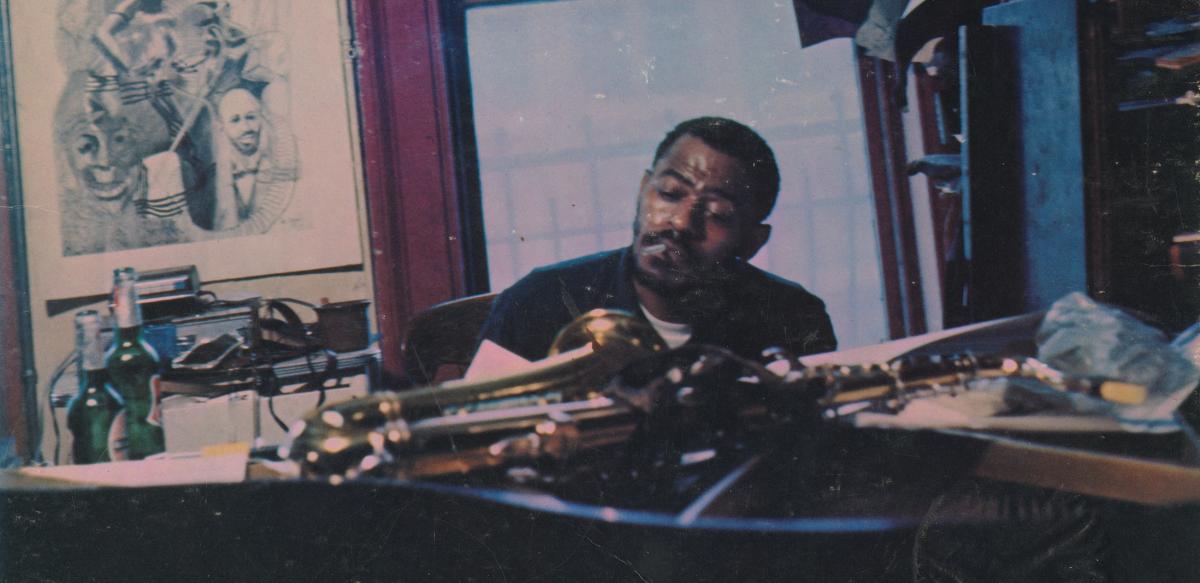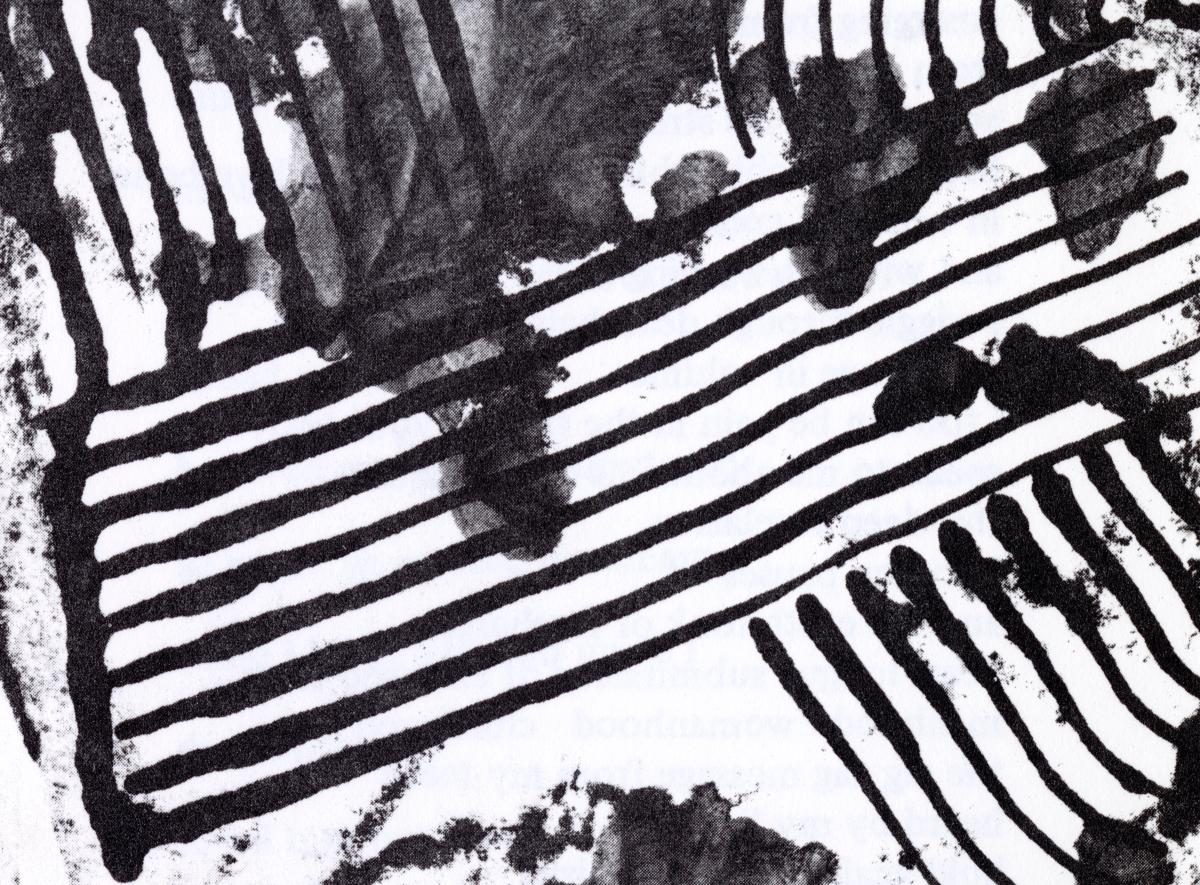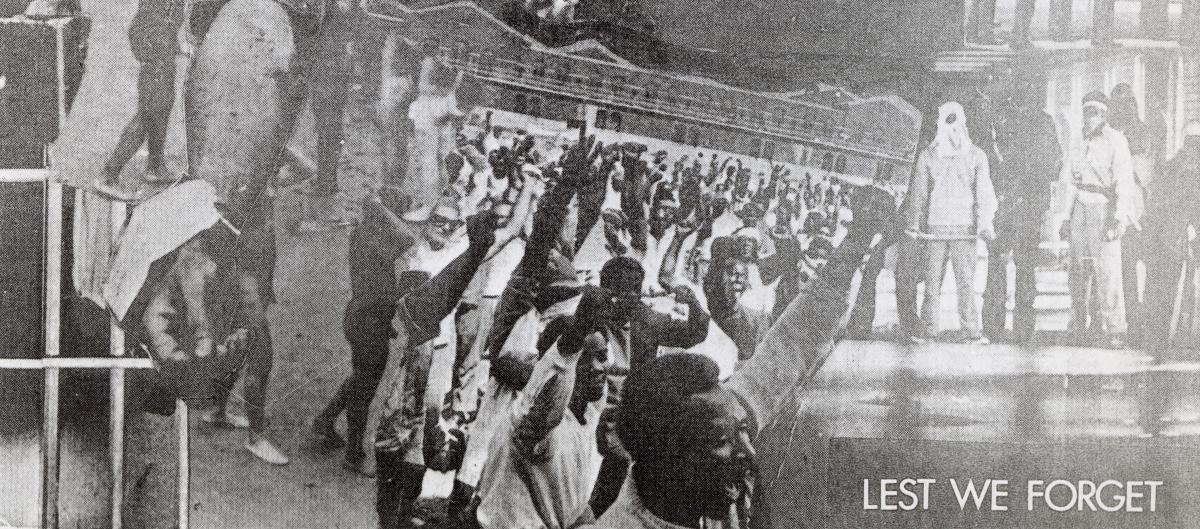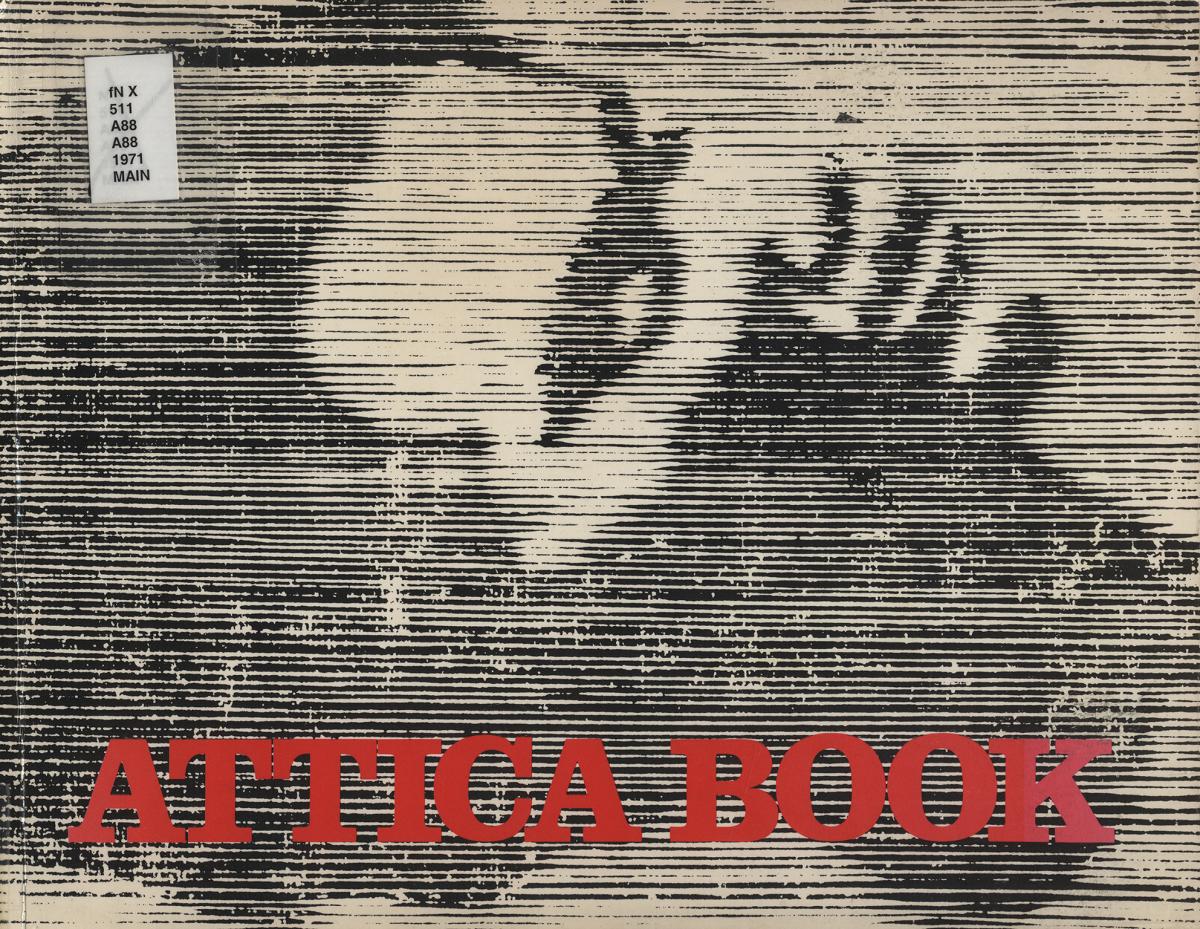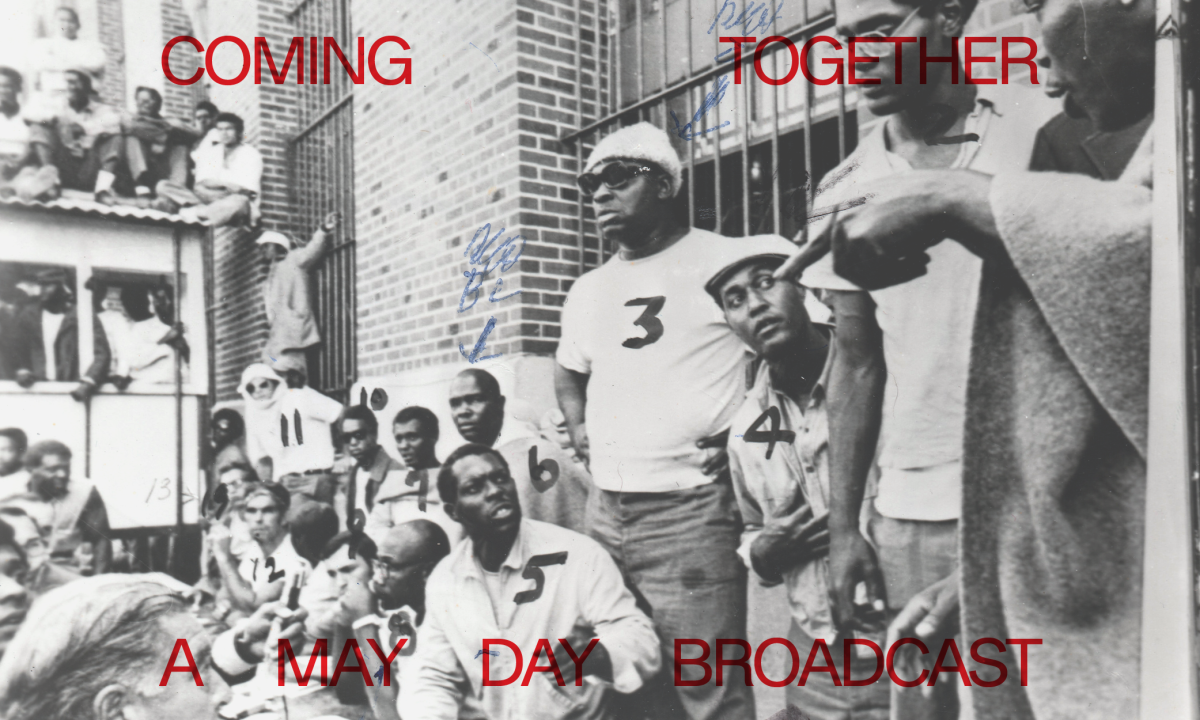
Detail from cover of Frederic Rzewski’s Attica / Coming Together / Les Moutons De Panurge (Opus One, 1974).
“People’s war is improvisation and more improvisation”, wrote George Jackson shortly before his death. “Improvising on reality is the key principle underlying the building of a united left and raising the consciousness of the people”, he continued. 1 “Even funerals can be used as an issue, since there will be so many of them. . . . [They] should be gala affairs, of home-brewed wine and revolutionary music to do the dance of death by.” 2 In the wake of the Newton–Cleaver split in the Black Panther Party, Nixon’s inauguration of the War on Drugs, Jackson’s own death, and the brutal suppression of the Attica prison uprising it inspired, it was hard to maintain such implacable determination; hard, too, to adequately mourn. “There are no tears / we have no friends / that is the word,” recites Jayne Cortez on Clifford Thornton’s Communications Network (Third World Records, 1972), her implacable, looping voice describing the dead end of endless “festivals & funerals / festivals & funerals / festivals & funerals & festivals & funerals.” 3
Despite the widespread reporting on the events at Attica, the event made relatively little impact on popular culture. There were B-sides by John & Yoko and Bob Dylan; there was Cinda Firestone’s 1974 documentary Attica, made when she was just twenty-three years old. And in Sidney Lumet’s Dog Day Afternoon (1975), Al Pacino’s petty criminal chants “Attica! Attica!” to whip up the crowd. That the latter is probably the best-known invocation of the uprising in popular culture suggests the difficulties in smuggling Black struggle into the sphere of the culture industry, an industry that often draws on the forms and feelings of Black life but only on the peripheries of other narratives. By contrast, the responses to Attica that I address here by Frederic Rzewski, Archie Shepp, and Charles Mingus, follow through on Jackson’s and Cortez’s prompts: how to turn funerals into festivals, or festivals into funerals; how to use the resources of improvisation that for centuries have provided ways for Black life to survive in the American necropolis.
Coming Together: Frederic Rzewski
Born to Polish-American parents the year before the outbreak of the Second World War, Frederic Rzewski played the piano from an early age, writing his first piece at the age of five, and went on to receive an Ivy League education. In 1960, he went to Italy on a Fulbright to study with composer Luigi Dallapiccola, whose rigorous but lyrical style, embracing the dodecaphonic compositional methods pioneered by the Second Viennese School, marked a critical reflection both on musical orthodoxy and its connection to the theater of fascism.
Questions of the relation between avant-garde art and politics were central to Italian musical life. Some of Dallapiccola’s own most important works, including Canti di Prigionia (1938–41) and Il Prigioniero (1944–48), address the experience of confinement. So too for Luigi Nono, a teenage Resistance member whose setting of the words of resistance fighters, Il canto sospeso (1955–56), had its premiere disrupted by fascists, and whose Intollorenza 1960 (1960–61) includes words from La Question, Henri Alleg’s vivid account of being tortured by French forces in Algeria. While Dallapiccola was unaffiliated with any party, Nono went on speaking tours at trade union societies, and in 1967 travelled Latin America, effectively as a “cultural ambassador” for the PCI, meeting and maintaining a correspondence with Víctor Jara before the latter’s murder six years later. Commissioned by Italian public broadcaster RAI in 1968, his Contrappunto dialettico alla mente set Sonia Sanchez’s elegy “Malcolm” alongside an anti-Vietnam pamphlet from the “Black Women Enraged” of the Harlem Progressive Labor Club; RAI rejected the piece out of fear of offending US representatives.
In different ways, Nono and Dallapiccola believed music to be a prime vehicle for expressing an avowedly anti-fascist politics without sacrificing musical avant-gardism for the dictates of socialist realism. Yet, in arriving at a stringent musical language through meditations on the political abuses of music and the complicity of musical tradition with fascism, their work moved further from intervention into a social life increasingly dominated by the mediations of the culture industry. Nono’s own music in particular became more and more oblique and opaque, whisps of sound emerging from eerie silences. His theatrical piece Prometeo (1981–85), was labelled not an opera but a “tragedy of listening.”
Such work reflected dilemmas that were both musical and extra-musical: a dialectical precipice I’ll come back to at the end of the piece. During the 1960s Rzewski, too, wrestled with these questions. His own solution avoided socialist realism, serialism, and the notion of the “composer as specialist” being advocated in the States by Milton Babbitt, whose infamous 1958 essay “Who Cares if You Listen?” suggested that advanced composition take place in the universities, subsidized by the state and disconnected from public life. Instead, Rzewski co-founded the egalitarian, leaderless ensemble Musica Elettronica Viva, seeking new ways of conceiving the musical ensemble. Expanding to a loose pool of around twenty musicians spread around Europe, from Steve Lacy and Anthony Braxton to Cornelius Cardew, and encouraging audience participation, M.E.V. performed in crypts, prisons, and hospitals. They believed, as Rzewski later asserted, that free improvisation could “create an entirely new language, so that people could come together from different parts of the planet and instantly communicate.” 4
Returning to the States in the early ’70s, Rzewski’s compositions outside M.E.V. echoed the medieval cantus firmus—a repeating melody surrounded by instrumental or vocal decoration, also used in Dallapiccola’s Canti di Prigionia—along with contemporary minimalism. Jefferson (1970), written for soprano Carol Plantamura just after the Kent State shootings, sets text from the Declaration of Independence over a simple, hypnotic cantus firmus, delivered almost conversationally. The piece seeks to extract a revolutionary message for a very different kind of revolutionary situation: “Whenever any form of government becomes destructive of these ends, it is the right of the people to alter or abolish it.”
But it was the diptych of Coming Together (1971) and Attica (1972) that represented Rzewski’s most enduring political statement to date. Coming Together sets words from a letter written by political prisoner Sam Melville shortly before he was killed during the Attica uprising:
I think the combination of age and a greater coming together is responsible for the speed of the passing time. . . . I am in excellent physical and emotional health. . . . In the indifferent brutality, the incessant noise, the experimental chemistry of food, the ravings of lost hysterical men, I can act with clarity and meaning.
As in Jefferson, the vocalist declaims over repetitive material: with only the bassline notated, Rzewski scores the piece for an indeterminate number of instruments, using the medieval hocket technique, wherein a repeated melody is shared between multiple instruments, to dramatize the collective aspect of social struggle and emphasize the role of improvisation in music and politics. As he later commented, the music is “about being as free as possible in an extremely confining situation.” In choosing Melville’s letter, Rzewski aimed at an insight into the psychology behind revolutionary dedication. But the piece is not a conventional piece of psychological realism or music theater. It focuses on the affective components of struggle in a manner both individual and generalizable.
In his program note, Rzewski observes: “Attica was originally intended to follow Coming Together after a short silence, so that the two pieces together would form a pair of dark and light images of the same subject.” 5 Melville’s optimism is overshadowed by our knowledge of his subsequent fate. Attica sets the ambivalent words of another prisoner released from the prison a few weeks afterward. Passing the Attica town line in the car taking him from jail, Richard X. Clark was asked by reporters how he felt now that Attica was behind him. Clark replied, “Attica is in front of me.” These words, with their refusal to forget, to “move on,” still ring true, and both pieces continue to be regularly performed, notably in a 2016 version by former political prisoner Angela Davis two days before Donald Trump’s election and a 2021 video performance recorded by Moor Mother in the Eastern State Penitentiary historical site in Philadelphia.
Continuing the quest to “strip [music] of its academic affectations,” in the 1970s Rzewski formed various small groups such as the Musicians’ Action Collective, a combination of free improvisers and folk musicians, to cut across barriers between pop music and high art, “bringing together audiences that would never normally meet, as well as bringing musicians together.” 6 The collapse of musical boundaries was also conceived as a breach of racial and class barriers, challenging the way that such obstacles were erected not only in terms of music itself but in the contexts in which it was produced. These groups performed not just in concert halls but at benefits for the Chilean Resistance and the Attica Defense Committee.
Increasingly, though, Rzewski returned to the concert hall tradition of the piano recital. Works like The People United Will Never be Defeated! (1975) and Four North American Ballads (1978–79) are extended variations on protest songs from Chile and the US, their musical language drawing equally on serialism, minimalism, jazz, and Beethoven. In De Profundis (1992), a setting of excerpts of Oscar Wilde’s famed prison letter for “speaking pianist,” Rzewki once more turned to the carceral questions of Attica and Coming Together, the sound of the performer’s amplified speech and breath emphasizing the bodily discipline that structures society both within and without the workplace, and the way individual bodies both suffer from and protest against such strictures. Like Nono or Dallapiccola, Rzewski confronts factory and prison alike, against which abolition’s horizon sets an alternative course. Yet within these desperate limits, the music is a breath of fresh air, like breathing, within and against confinement, in a spirit of fragile solidarity and patient transformation.
Attica Blues: Archie Shepp
In 1972, Archie Shepp was a controversial presence on the US jazz scene. Mentored by John Coltrane, who’d landed him his recording contract with major label Impulse! records, his polemical interventions in the pages of white-dominated publications like DownBeat saw him denounced as a Communist and “Crow Jim” reverse racist. Proclaiming himself “an anti-fascist artist,” Shepp defined jazz in a 1966 panel discussion as “anti-war; it is opposed to Vietnam; it is for Cuba; it is for the liberation of all people. . . . That’s not far-fetched. Why is that so? Because jazz is a music itself born out of oppression, born out of the enslavement of my people. It is precisely that.” 7
Shepp’s music drew from the raucous energy of Charles Mingus, the compositional élan of Duke Ellington, and the suite-like structures of Don Cherry and Sonny Rollins, along with the piquant dissonance of Cecil Taylor and, in his own playing, the raw, open sound of blues shouters and R&B “honkers.” Records like Three for a Quarter, One for a Dime(Impulse!, 1969), recorded in 1966, provided Black Power-era updates of earlier forms of collective improvisation, while the percussion-heavy The Magic of Ju-Ju (Impulse!, 1968) manifested a neo-African aesthetic. In 1969, Shepp travelled to the Pan-African Cultural Festival in Algiers. Upon landing on African soil, he and drummer Sunny Murray kissed the ground. Later, they performed with nomadic Tuareg musicians in a repurposed boxing ring. The concert has since served as an icon of Pan-African solidarity.
Shepp also participated in the internationalist circles of New York’s Black cultural left. As a member of the Jazz Composers’ Guild, a collective of free jazz musicians organised by Bill Dixon, with whom he’d formed his first band, he was outspoken on labor issues. In 1965, Change magazine published a letter he wrote to Harlem congressman Adam Clayton Powell urging that new legislation take into account the struggles of Black musicians. “There exist in New York alone thousands of unemployed musicians,” Shepp wrote.
Union representation is at best poor where it exists at all. We are given only token access to the best money-paying jobs, i.e. the major television networks, theatre and motion picture engagements, etc. Opportunities for further study and academic advancement such as those so gracefully offered by Messrs. Fulbright, Whitney and others are tacitly denied us. 8
If Rzewski was breaking out of the classical ivory tower and the bourgeois concert hall, Shepp sought institutional recognition while insisting, “My music is for the people. If you are a bourgeois, then you must listen to it on my terms.” Yet he was aware that his audiences were largely small circles of white bohemians, rather than those who flocked to James Brown, Otis Redding, or Aretha Franklin. As with Nono and Dallapiccola, a contradiction arguably emerged between the formal innovations to which the music had led Shepp and his compatriots, and his desire to reach a popular Black audience; between the music’s class origins and its class audience.
Interviewed by Black Arts architect Larry Neal in 1965, Shepp stated: “I think my music is derived from the culture of the poor, a common culture.” Yet,
I think it will be a long time before the Black Artist and the Black community can really stand next to each other because so much has been done by power to separate them. . . . It would be very difficult for Cecil [Taylor] or Ornette [Coleman] or myself to just go up to Harlem and expect to be accepted right away . . . 9
In Shepp’s view, some popular musicians had “an intuitive working-class instinct,” but the Black intelligentsia possessed “a certain overview” that could give “order” to that instinct and “make it meaningful.” 10 At the same time, he argued that the new musicians listen more closely to singers like Dionne Warwick and Ray Charles, reflecting that he might have to “get into rock and roll . . . slide into that, and refer to the people so that they’ll know what I mean.” 11
Shepp’s music had always been wide-ranging: standards, Ellington pieces, “The Girl from Ipanema” and “The Shadow of Your Smile” alongside early twentieth century blues and marches, all rendered in a style capable of alternating between sardonic, near-satirical exaggeration and devastating, swooning sincerity. But as the decade turned, Shepp made a concerted effort to reach a wider public. Things Have Got to Change (Impulse!, 1971) was built around a movement from Calvin Massey’s Black Liberation Movement Suite (ca. 1960–70), a commission Massey had received from Eldridge Cleaver, the Black Panther Party’s exiled Minister of Information, while traveling alongside Shepp to Algiers. 12 Massey, a friend of John Coltrane whose apartment was an open house for New York’s younger Black jazz musicians, had a unique flair for the dramatic, while the band Shepp assembled combining sung and chanted vocals with collective improvisation over a propulsive groove, its community aesthetic exemplified by the presence of members of Shepp’s family chanting “Hey, godammit! Things got to change.”
These lyrics were the “street poetry” of Shepp’s drummer, William Godwin “Beaver” Harris, and it was Harris who suggested Shepp record an album on Attica, linking up radical lawyer William Kunstler, director of the American Civil Liberties Union (ACLU), who’d been involved in the negotiations to save the prisoners and had earlier worked with musicians Gigi Gryce and Benny Golson in their attempts to form a publishing company. When interviewed by Val Wilmer, Harris emphasized the album’s potential:
Each one of us likes certain kinds of music. That’s why I refuse the idea that our work could be confined to a single category. There’s a lot of things in our music, many diverse elements, because we try to communicate with the largest possible number of people. . . . Classical music is a class music. But we want to do away with this idea of class. That’s why it’s important that all the young people know that jazz—black music—is their music, and that they’re part of it. It’s the music of the people. . . . That’s why William Kunstler feels part of it too, because it’s the music of the people. 13
Harris’ comments dovetail with a story Shepp has often repeated in subsequent years. At his mother’s funeral in 1970, a family friend remarked: “Well, Archie, I’ve got a lot of your records. When are you going to play something that I can understand?” 14 In retrospect, Shepp has argued: “I began to see and reflect that basically the audiences for this music were essentially white, middle-class audiences. That very few black people really listened to what I was doing.” 15 Problems with his embouchure, in part resulting from the strain of having played loud, long, and fast for nearly a decade, also played a role. He took up soprano saxophone, yielding a brighter, piping sound, and toned down the more discontinuous, tonally and rhythmically volatile aspects of his playing.
Structurally, Attica Blues transposes developments which were already ongoing in Shepp’s music to a more “accessible” register. On earlier records such as Three for a Quarter, One for a Dime, other instrumentalists were liable to “interrupt,” accompany, and play alongside the soloist at any given point: a collective conversation somewhere between a political meeting, a church service, and a street rally. Attica Blues adds singers and a backing chorus—lead vocalists Joe Lee Wilson, Henry Hull (Carl Hall), and Waheeda Massey; backing singers Albertine Robertson and Jo Armstead; and reciters Kunstler and Bazzi Bartholomew Gray—who comment on the instrumental solos that comment on them in turn. Shepp here draws on the R&B, gospel, and soul traditions of the singers poet Kate Rushin calls the “black back-ups,” who, like the Chorus of ancient Greek tragedy and the call-and-response of traditional African music, play the role of social conscience and commentary, a device that both distances and heightens emotions. And, as on a rock concept album, spoken interludes by Kunstler and Gray unite disparate tracks.
In this, Shepp also draws on his theatrical and poetic heritage: from recitations on his tracks such as “Malcolm, Malcolm, Semper Malcolm,” “Scag,” and “The Wedding,” to his work off-Broadway, scoring a 1969–70 production of Amiri Baraka’s Slave Ship, his own play The Communist/Junebug Graduates Tonight (1967), and, with Massey and Stanley Cowell, Aishah Rahman (Virginia Hughes)’s Lady Day: A Musical Tragedy (1972). These plays each concern problems of community in which an individual is drawn into ambiguous relation with a collective, reaching either resolution or tragic dissolution in the end. And that community sounds out in full, explosive force on the title track, with awild and unusual string arrangement (uncredited, but likely by either Cal Massey or Shepp himself) and a boiling vocal by singer Carl Hall (credited as Wolfman actor Henry Hull), a singer with a four-octave range and a former cast member of Langston Hughes’ Tambourines to Glory (1963), of whom Stephen Davis argued that his “ultimate vocal range seems to fall somewhere between Michael Jackson and the noon siren.” 16 Backing vocalists Robertson and Armstead—a former Ikette who’d also performed backing vocals on Bob Dylan’s “George Jackson” single—sound more like the Maenads than the Raelettes: a furious voice of the people in overlapping, fractious re-iteration.
Musically and thematically, Attica Blues looks backwards and forward at the same time. As a whole, there’s something surprisingly old-fashioned about the music on the album, which is closer to traditional blues, swing, and big band than to the forms of “jazz-rock” or “fusion” then achieving crossover success. In part a “with strings” project like those of Charlie Parker in 1950 and Clifford Brown in 1955, the album features ballads over lush, gentle arrangements, and it often reflects, through lyrics by Harris, Massey, and Gray, on the fragility of life and the figure of the child. The second piece, “Steam,” would soon become a staple of Shepp’s performing repertoire. Lilting and bittersweet, it’s dedicated to “Steam Mincer, a distant cousin . . . stabbed to death at the lonely age of fifteen.” 17 Joe Lee Wilson’s vocals and Shepp’s soprano soar over the stringers while Wilson lets out an exhale in poignant allusion to Mincer’s nickname. Gray’s spoken “Invocation to Mr. Parker” celebrates Black music’s defiance of class barriers—“Where’s that driving music man, / used to wail out back? Never knew where he came from; / could have been a castle or a shack.” Shepp’s “Blues for Brother George Jackson,” a boiling instrumental blues, menacingly funky and defiant, leads, via Kunstler’s stentorian interlude, to “Ballad for a Child,” where Carl Hall’s vocals take on Motown sweetness matched by Shepp’s mellow and melodic tenor solo. Two pieces by Massey close out the record: a dramatically poignant instrumental tribute to the late Louis Armstrong, “Goodbye Sweet Pops,” and the concluding “Quiet Dawn,” sung by Massey’s preteen daughter, Waheeda. Waheeda’s vocals, sometimes struggling to hit the pitch, suggest an openness to amateur musicianship once more reflecting the community ethos of Things Have Got to Change. Rather than a call to arms, this is a ballad of regretful hope, in the context of the record using the framework of the love song as index of political aspirations. In setting the dead of Attica and the passing of love alongside the voice of a child, and the big band and “with strings” traditions alongside elements of R&B and soul, Shepp presents a kind of nostalgic futurism.
The record was certainly received as something of a rapprochement. Rolling Stone demanded that it be “played by every radio station in the country”; 18 DownBeat afforded it five stars. On Independence Day, 1972, Shepp performed at Attica prison itself, sponsored by a National Endowment for the Arts-funded nonprofit organization. 19 Speaking to me in 2021, pianist Dave Burrell recalled: “When we played Attica we were locked in the prison . . . a lot of the inmates knew a lot of us, we were on the street together, so to speak, before they were incarcerated. It made me more aware and I think more determined to survive, thinking that the America that I had envisioned, and still envision, was yet to be acknowledged.” 20 In some ways it’s hard to imagine how the outspoken Black Marxist could play this work of protest at the very prison that inspired it, paid for by the state. Perhaps it was part of a broader state strategy to turn dissonance into consonance, to dilute Black art’s energy through a tokenistic politics of representation. Shepp began a thirty-year career at the University of Massachusetts, Amherst, in 1971; Cecil Taylor, was hired one year prior at the University of Wisconsin on the back of a student strike that had brought 2000 armed national guards to the campus. These were undoubtedly achievements, won through political struggle. But they also raised new questions about the political role of the music. I’ll return to these questions at the end of the piece. But for now, I want to turn to a third response to the events of Attica: that of bassist and composer Charles Mingus.
Remember Rockefeller at Attica: Charles Mingus
Mingus’s outspoken politics and early attempts at musicians’ organizing are important predecessors for Shepp’s own work. Though sometimes critical of free jazz, in the 1970s, Mingus assembled a new group incorporating younger, avant-garde oriented players including trumpeter Jack Walrath, former Milford Graves collaborator pianist Don Pullen, and the explosively lyrical tenor player George Adams, alongside his long-term drummer Dannie Richmond. In December 1974, this group recorded not one but two records, Changes One and Changes Two on Atlantic. “Changes”—the recurring chordal patterns on which jazz improvisations are built—served as models for the conservative “jazz police,” who viewed any attempt to play outside such patterns as heresy. But in Mingus’s hands, changes are more like the “changing same,” the rapprochement of radical tradition and innovation posited by Amiri Baraka in 1966 as a meeting ground between the Black popular and avant-garde traditions.
Mingus had previously recorded pieces with titles like “Haitian Fight Song,” “Meditations on Integration” (aka “Meditation (For a Pair of Wire Cutters)”), and “Once Upon a Time, There Was a Holding Corporation Called Old America.” Both Changes albums likewise open with politically-charged titles: “Remember Rockefeller at Attica” on Changes One, and “Free Cell Block F, ’Tis Nazi USA” on Changes Two. “Remember Rockefeller” has a lengthy, fifty-one–bar chorus, ending on a kind of suspended note that suggests a further section to the melody that never quite comes, as if pushing the discursive frames of the traditional jazz “head” to their limit, while “Free Cell Block” is at once flowing and trickily changeful, alternating 5/4 and 4/4 meters. In these extended themes, melodic figures are varied and transposed, nearly forgotten in their original form when they return as the closing tag, stretching the limits of memorability while remaining profoundly singable. The music breaks out of the confines of bar lines, cell lines, color lines, and the lines of the possible, serving as living alternatives to the limits of the prison wall, the cop’s baton, and the guns of the National Guard.
This being said, there may seem to be little initial connection between titles and compositions. For Mingus, titles were improvised pegs to hang the music on: when Republican vibes player Lionel Hampton refused to record a piece titled after Attica, Mingus renamed it “Just for Laughs, Saps.” 21 Mingus never claimed that this was programme music. But as jazz was increasingly used to promote a middle- class aspirational lifestyle—a trajectory leading from Hugh Hefner to Kenny G—the equally “arbitrary” linking to politics forms a vital counter-function. As he told Nat Hentoff: “I ought to give titles to my music that may make people think. . . . That’s the part to remember—that Rockefeller is a very dangerous man.” 22 The music exists both in spite and because of Attica. Rather than protest music, it’s everything at once, refusing the confines imposed on Black artists—a careening canvas of Black life.
“I want capitalism, the same thing everybody else has got,” Mingus once claimed, referencing his experiences traveling through communist countries. “You want communism? That’s some sick shit, man.” 23 But he remained an outspoken critic of US foreign and domestic policy. In summer 1975, the KKK fired on a birthday party full of children in Kalamazoo, Michigan; that November, performing “Free Cell Block F” in Chicago, Mingus and long-time drummer Richmond chanted “Smash the KKK” as they played. 24 The same year, he played Communist Party-sponsored festivals in Italy, and was set to perform a PCI-sponsored tribute to Mao Zedong and the South African struggle alongside Shepp and Max Roach before pulling out for contractual reasons. 25 [5] Meanwhile, on a State Department-sponsored tour of Europe, he embarrassed US embassy representatives with what one official called “references to American political figures and incidents that we simply could not allow in a government-operated cultural center.” 26
Throughout, Mingus took the promises of American liberty at their word. As he puts it in Thomas Reitman’s 1968 film portrait, Mingus:
I pledge allegiance to the United States of America. I pledge allegiance to see that someday they will live up to their own promises to the victims that they call citizens. Not just the black ghettos, but the white ghettos and the Japanese ghettos, the Chinese ghettos, all the ghettos in the world. Oh, I pledge allegiance alright—I could pledge a whole lot of allegiance! You think I’m jiving?
Mingus remained politically outspoken to the end. In 1976 he wrote music for Elio Petri’s Todo Modo, a dark farce mocking Italian Prime Minister Aldo Moro shortly before Moro’s kidnapping by the Red Brigades. While dying in Mexico, Mingus lectured his son on the importance of Paul Robeson. His ashes were scattered in the Ganges: in death escaping the America against which he railed, whose trends towards totalitarianism he’d warned against, whose legacy of genocide he noted, and whose democratic redemption he wished for.
“If they take you in the morning”: Music and Politics after Attica
Neither Shepp’s nor Mingus’ work on Attica received attention outside the relatively small jazz world, its neglect in the broader culture reflecting the growing invisibility of Black Power in the wake of COINTELPRO and into the ongoing era of the War on Drugs, financialization, surveillance capitalism, gentrification, and the ever-expanding prison-industrial complex. In 1970 and 1971, both Shepp and Mingus participated in the Jazz and People’s Movement spearheaded by multi-instrumentalist Rahsaan Roland Kirk, that sought greater employment of Black musicians and technicians in television and radio, as well greater representation for Black music’s historical roots in blues and jazz. On the Ed Sullivan Show, Kirk, Mingus, Shepp, and Roy Haynes launched into an unscheduled version of Mingus’s “Haitian Fight Song” to the host’s bemusement.
Meanwhile, Shepp had started a group called Black Artists for Community Action. Aiming to put similar pressure on wealthy institutions such as the Guggenheim and Rockefeller Foundations, he, Kirk, Roswell Rudd, and others staged a play-in at the Guggenheim’s New York offices. Classical music wasn’t expected to compete in the commercial arena, but instead existed through state and private subsidies, and jazz should receive similar support.
Ultimately, both campaigns fizzled out. Jazz remains largely absent from commercial TV. While funding bodies gradually began sponsoring Black musicians, the field remains white-dominated. Shepp lost his contract with Impulse! after the follow-up to Attica Blues—an orchestral album entitled The Cry of My People (1972)—instead pursuing his career as an academic at Amherst, touring and performing, mainly in Europe, and reinventing himself as a performer of standards, ballads, and blues.
With musicians like Shepp and Bill Dixon employed as part of the new Black Studies programmes initiated through student agitation, they could disseminate their ideas and music to students, and, as Shepp saw it, preserve the music’s history outside the commercial marketplace where it was increasingly threatened. Yet, in doing so, they acknowledged that the attempts to build a people’s music, community education projects and so on, lacked the ability to compete with white institutions. Meanwhile, an increasingly dominant aesthetic and political conservatism, exemplified by the Jazz at Lincoln Center project, reinvented jazz as an emblem of middle-class respectability politics: swinging music played by men in suits in multimillion-dollar subsidized concert halls built as part of racialized gentrification policy.
Rzewski, Shepp and Mingus’s struggles to change the context for radical music remain incomplete. The classical world remains elitist; the jazz world either precarious or selectively taken up as lifestyle emblem. These dialecticalcontradictions cannot be answered in music alone, but, as these three composers show, music produces affective ground to reflect upon being caught on such precipices; improvising on reality, in a world of festivals and funerals, in the pain and joy of struggle.
With its tributes to the dead—whether musicians, family members, or political figures—Attica Blues was already a work of mourning. The lyrics to its closing song, “Quiet Dawn,” speak of passing time, using the classic poetic trope of the approach of daylight and the end of the night.
It’s quiet dawn
And life moves on . . .
Oh come, let’s love
Before the dawn is gone
Come dawn, don’t flee
Come back to me
Let’s try one more night
Before the dawn is gone
On the one hand, this is a bittersweet song of passing love. But it’s also a warning. In January 1971, Shepp’s friend James Baldwin wrote an open letter to then-incarcerated Angela Davis. “If they take you in the morning,” he observes, “they will be coming for us that night.” 27 Like Shepp, Baldwin turns this register of threatened mourning into one of vigilance and urgent militancy. Shepp’s urge to mourn, Mingus’s injunction to “Remember Rockefeller at Attica,” suggest that memory and mourning can also be militant. And so we end with the lesson reiterated in Rzewski’s Attica, those words of Richard X. Clark that refuse to make the past the past. Attica is still in front of us, the dawn approaches, and they’ll be coming in the morning. This message must resound every time this music is heard and continue to do so until the walls of the last prison fall.
